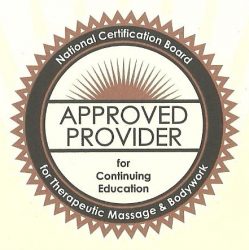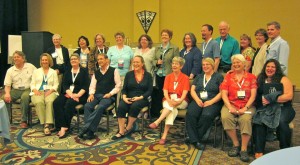Yes, I’m in pain. Believe it or not, it pains me to write negatively about the National Certification Board for Therapeutic Massage & Bodywork. I am personally acquainted with many of the people who work there, from the CEO, Mike Williams, on down, to Board members, staff members and volunteers. I count some of them among my friends. I know for a fact that they are dedicated and hard-working people.
I’ve been NCTMB since 2000 and an approved provider of CE since 2002. I’ve seen the ups and the downs of the organization: the days of great service, and the days of bad service. I’ve seen the leaders who had the best interests of the profession at heart–and one or two who were on a personal mission to bring down the organization with their wild spending and lack of professional ethics. And I’ve seen–and even been a party to–some of their missteps. A couple of years ago when they announced an advanced certification exam, I signed right on. I even appeared in an advertising campaign for it, along with quite a few other well-known massage therapists, educators, and even some illustrious physicians. The failure of that project, I believe, was because it was a general thing, and not a specialty certification–which the profession has been requesting for quite some time.
CEO Mike Williams responded to my Wish List blog last week. I met Williams at the AFMTE meeting a couple of months ago and spent a very enjoyable couple of hours talking with him one-on-one. I hear (from other folks, he wasn’t bragging) that he has a proven track record of helping floundering organizations get back on track. He even joked to me that he had learned everything he needed to know about the NCB from reading my blog.
You can’t please all of the people all of the time, and I know that just from the comments I receive on this blog. However, distress at their latest action seems to be shared by more than a few people. The NCBTMB sent out an application for a new assigned school code to massage schools this week. Now, the organization has required a school code since the beginning; it’s just a number that students must include on their application to sit for one of the NCB exams, and it is supposed to demonstrate that the school is legitimate. That’s good in theory; and I think the original intent was to keep schools and/or individuals from falsifying diplomas and transcripts.
A number of school owners went up in arms this week when they received the application. True, it is just seven pages long, and that’s way less than what is required for a state board school approval or COMTA accreditation…but therein lines the issue: except for the schools in the few unregulated states, these schools have already been approved by their state boards, and in some cases, one or more accrediting bodies as well.
One school owner on my FB page said “We are opting out. The list of required paperwork is oppressive. Our school is now sending them all off to the Mblex. It’s moves like this that, in my opinion, will seal the deal of completely making the NCBTMB irrelevant. We had a school code with them, we maintain state approval which can be verified easily on the state website. The additional hassle which this organization seems to thrive on is over my tolerance level.”
Another sore point is the human trafficking angle. Now, I don’t think anyone is in favor of human trafficking except the people who are making a living off of it. As background, there has been legislation introduced in a few states requiring massage establishments to post notices about human trafficking–something that isn’t required in a convenience store (in other words, they’re picking on us again, supposedly because massage is a business in which it’s a big problem). On their 2010 990 filing, the NCB reported giving a $5000 donation to the Polaris Project, which fights human trafficking. They also started publishing brochures about human trafficking and selling them (at 2.50 for 25 of them, I don’t think they’re getting a big revenue stream off of that).
On the application that came out this week, school owners are being asked to sign a pledge about not participating in human trafficking, and doing whatever they can to stop human trafficking. I got calls from a few people that were upset about that; they stated to me that the NCBTMB was overstepping its boundaries and giving a false impression of having regulatory or law enforcement authority. Personally, I think any entity donating money to the Polaris Project and doing their part to fight human trafficking is admirable, but as someone on my FB page pointed out, is there really any school actually participating in such a thing that wouldn’t just sign the pledge anyway? It’s like asking people if they use illegal drugs on a job application. No one is going to write down that they have a cocaine habit, are they?
On the NCBTMB website, there are a couple of dozen schools listed as having their school code suspended, revoked, or denied. The reasons are not given, so one doesn’t know whether they were found to be participating in human trafficking, running a diploma mill, or what.
In his response on my blog, CEO Mike Williams talked about the forthcoming improvements from the NCB. Let me say, as much as it pains me: different singer, same song. I must make it clear that I have wanted this organization to survive, and thrive, but I am very concerned. And as Angela Palmier pointed out in her comments, people laughed when there was talk of another entity creating a licensing exam. In the meantime, the MBLEx has proceeded to saturate the market and it will just continue to get bigger and bigger–even if the NCBTMB steps in to challenge the states’ right to choose, like they did last week in Tennessee. They did actually prevail there, but at what cost? The Board members were upset, the GR rep from AMTA was upset, and in the end, the decision for the Board to acquiesce was based on their desire not to see their other impending legislation get scrapped in the crossfire.
In addition to the FSMTB sticking their toe in the water to test the profession’s reaction to their CE plan, I’ve recently been contacted by several people about starting (yet another) CE approval body. It wouldn’t happen overnight, but there’s no reason to think it can’t be done. For that matter, there is nothing to prohibit another entity from starting another certification agency….just like there are numerous accrediting agencies besides COMTA. It could happen.
I don’t doubt that the NCB has good intentions–but as we all know, good intentions are sometimes misguided. Placing an additional and very unnecessary burden on school owners is misguided and the perception is that it’s one more example of duplicated efforts in this profession. Challenging state boards is misguided. The NCB needs all the public support they can get, and that isn’t winning them any friends. It is creating ill will, period. Hanging on to entry-level licensing instead of focusing on becoming the one true certification agency is misguided. That’s my story and I’m sticking to it.


